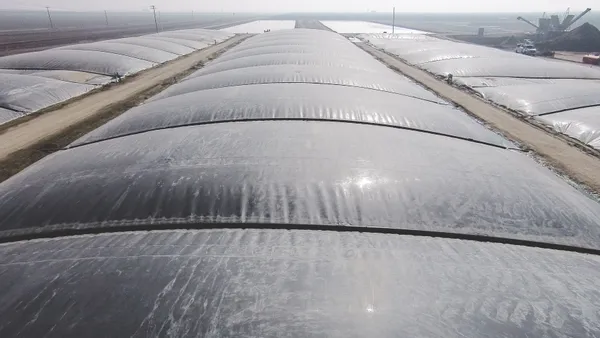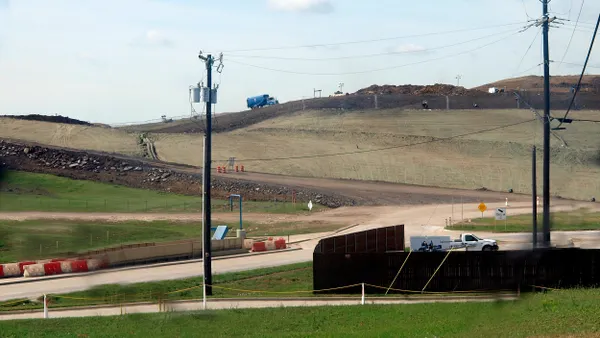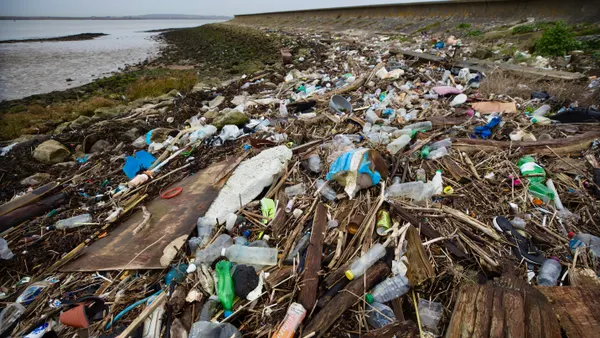Dive Brief:
- A group of environmental organizations led by Eco-Cycle is calling on the Colorado Department of Public Health & Environment to update landfill regulations, allowing for the use of newer technology and the capture of more emissions.
- Colorado received $129 million from the U.S. EPA through the Climate Pollution Reduction Grants program. In the application, state regulators highlighted plans to bolster methane monitoring efforts, including at Colorado's 59 landfills.
- If it tightens its regulations beyond federal requirements, Colorado would be one of several states to do so, joining Washington, California, Maryland and others.
Dive Insight:
A growing group of environmental and climate action groups around the world are urging regulators to act on landfill emissions. They cite both environmental justice concerns and a growing understanding of the amount of methane released by landfills, a pollutant with a global warming potential 80 times stronger than carbon dioxide over a 20-year period when emitted into the atmosphere.
The state has already had methane in its crosshairs. It launched an aerial survey pilot in 2021 that used several different technologies and was aimed primarily at oil and gas facilities. But as that pilot has progressed, and the state has developed a better understanding of landfills' own methane contributions, the CDPHE is looking to expand its work.
Eco-Cycle, a nonprofit hauler and recycler in the state, was joined by two dozen organizations in signing the Oct. 16 letter, including research group Industrious Labs. The coalition called on Colorado regulators to take four steps to improve regulations on landfills, some of which align with recommendations that Industrious released in a report directed at the U.S. EPA earlier this week.
That includes a call to lower the threshold at which landfills must install gas collection and control systems — the Eco-Cycle letter recommends the requirement apply to all landfills with at least 200,000 tons of waste in place. The groups also recommends that landfill operators install the system "at the earliest feasible time" and "reduce lag time in installation to less than a year."
Like the recent Industrious report, the letter called for enhanced landfill cover regulations. The coalition said that CDPHE should minimize the size of the active working face and require landfill operators to deploy the most modern cover materials that can help oxidize methane.
The letter further encouraged CDPHE to enhance its advanced monitoring approach by broadening the use of monthly drone-based monitoring, continuous emissions monitoring and other advanced technologies like satellites.
Finally, the coalition urged CDPHE to encourage the diversion of organic waste from landfills. The EPA reaffirmed last year that source reduction of food waste from disposal like landfilling or incineration is the most beneficial way to use the material. It also noted in a report released around the same time that organics contribute 58% of MSW landfills' fugitive methane emissions.
Colorado municipalities have begun to take early steps to address organic waste with the support of state agencies. Denver, the state’s largest city, is in the process of expanding residential organics collection. Even so, the state is behind on its plans to reach a diversion goal set by the Solid and Hazardous Waste Commission in 2016. The state hopes to reach 45% waste diversion by 2036, but diversion rates have remained relatively flat over the last few years, reaching 15.5% in 2022, per a report from CDPHE to the legislature earlier this year.
The CPRG program funding could assist with those efforts. In addition to Colorado's stated plan to enhance methane monitoring, the state is also planning to create support for municipalities through its Local Climate Action Accelerator program. It envisions that program will help jurisdictions increase their diversion rates through policies like mandatory recycling or composting, pay-as-you-throw systems or other measures.
Colorado's climate action plan, which it developed as part of the CPRG program process, estimated that the state's landfills emit a combined 1.3 million metric tons of carbon dioxide equivalent annually. Many of the industry’s largest landfill operators have facilities in the state.
The National Waste & Recycling Association said it looked forward to working with Colorado regulators as they ramp up environmental standards.
“Our industry continues to partner with regulatory agencies and invest in innovative technologies, from aerial and ground-based detection tools to gas-to-energy projects,” said CEO Michael E. Hoffman in an emailed statement. “We believe that a thoughtful, comprehensive approach is essential for accurate emissions assessment and effective, sustainable solutions.”
CDPHE did not respond for a request for comment.











